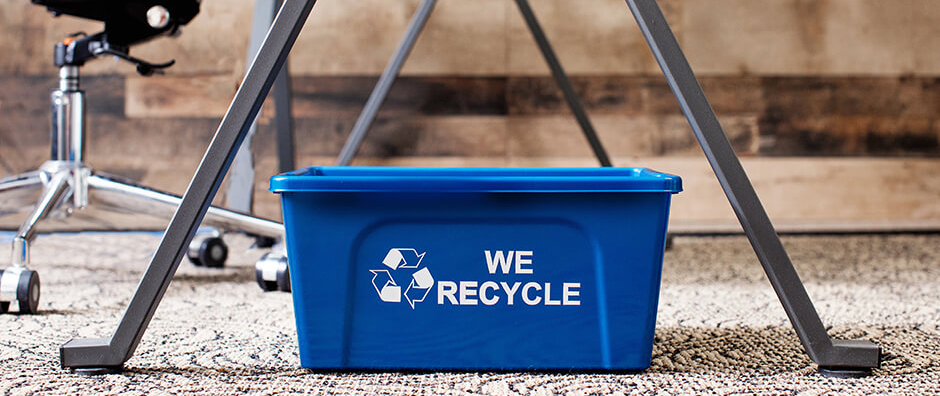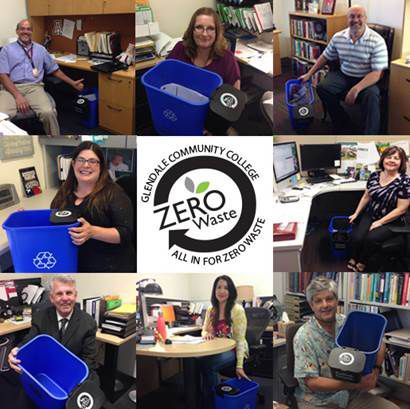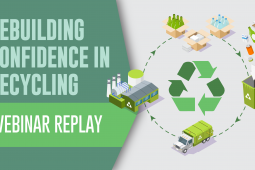Here’s a basic premise: to increase the amount of recycling you collect, add more recycling bins. Straightforward enough, right? But what if you already have recycling bins next to every trash bin and people still aren’t participating? The fact this question needs to be asked gives a clue as to why so many sustainability managers have jobs. After all, if it were as simple as setting out recycling bins and sending someone to empty them, the recycling profession would essentially be limited to collection workers.
So what are the secrets to a successful recovery program? Education, obviously. Make sure trash and recycling bins are designed around best practices. Carefully wordsmithed signage. All of these will deliver incremental improvements to recycling. With this series of blogs, I’m focusing on another emerging but still under-appreciated practice shown to deliver major improvements: reshaping the infrastructure of waste bins and the corresponding service model. This concept can be manifested in a number of ways, but the underlying principle is for fewer, more centrally-located bins and greater responsibility for individuals to handle the waste they generate. Future blogs will talk about how this applies to classrooms and outdoor areas. With this initial three-part series, I’m focusing on ways to modernize office deskside arrangements. What does it look like, and how exactly do they benefit the organization?
I’ll confess up front what this has become for me… “obsession” is a little strong. How about a “driving professional interest”? I started my career in the recycling field in the early ’90s as a student coordinator and later the facilities-based solid waste reduction manager for Humboldt State University in Northern California. One of the first projects I worked on as a student was to set up the original network of 23-gallon paper recycling bins in the hallways of academic and administrative buildings. Staff and faculty for the first time had somewhere reasonably convenient they could recycle scrap paper. Despite this progress, a quick stroll through empty offices at the end of the day revealed workstation waste-baskets full of paper. Nightly housekeeping service of the bins meant that the trash option remained at people’s fingertips, while recycling required searching out the paper bins down the hall. The arrangement still implicitly endorsed trash as the preferred disposal option. Union politics and an ever-shaky state budget prevented adding deskside recycling to the housekeeper’s routine. So instead I spent the next 14 years I was at Humboldt advocating for the only other option that put trash and recycling on equal footing: eliminating deskside trash from the housekeeper’s duties. Never happened. I still think about it today… Obviously.
Undoing the Structural Bias Against Recycling
The situation at Humboldt mirrors in some form that of most colleges and universities. Over time, many have chipped away at this structural bias, adding a corresponding recycling bin and possibly even housekeeping service. But even where trash/recycling basket parity exists, a substantial amount of deskside recyclables (not to mention compostables) still end up in the wrong bin. Facilities’ departments are full of engineers. To think of it through their lens, a system designed to divert recoverable waste that misses, say 25% or more of it, is inefficient.
Over the last 10 or 15 years, a growing number of schools have reimagined how deskside waste is handled. There are a number of different permutations. The most common one I’ve seen provides each workstation with a smaller, black 3 qt bucket that hangs on the side of a regular-sized 14 or 28 qt blue recycling bin. Schools with dual-stream recycling or an aggressive organics collection program might add a second hanging basket. Schools of all shapes and sizes have implemented this system. There are a number of programs based on this model worth looking at, including 4-year schools like the University of Washington, IUPUI, and UNC Charlotte. Glendale Community College in Arizona has a very good example of a 2-year school program.
Many schools, of course, simply use equal size trash and waste-baskets. These at least ensure an equal level of convenience assuming the service arrangements are identical. However, the advantage of the smaller hanging trash basket was revealed in 2014 study I was peripherally involved with when I worked for Keep America Beautiful (KAB). The study used waste audits in 34 offices around the US to compare both configurations, as well a third that left office workers with recycling but no trash bin. While having equal-sized bins reduced contamination by 17%, the data showed no significant reduction in the number of recyclables ending up in the trash. The locations with the small hanging trash baskets resulted in a similar reduction in recycling bin contamination but also decreased the amount of recyclables in the trash by as much as 29%. The locations that removed the trash but left a recycling bin offered a cautionary tale: a 14% increase of recyclables tossed in the trash. You can find a brief fact sheet of the study online, as well as the full 126-page report.
In the last few years, some early adopters have taken a leap into the unknown by simply removing deskside bins altogether, both trash and recycling. Tech companies with an impressive 90%+ diversion rates, like Oracle and HP have done away with personal bins. While I’m only aware of a few higher ed institutions that have actually done this, I suspect there are others out there. Polytechnique Montréal already had the classic small-trash-hanging-from-regular-recycling arrangement in place when they took the next step in 2019 by removing all bins from grad student offices. Waste audits that would have measured the impact were, unfortunately, short-circuited by the COVID-19 outbreak. Patrick Cigana, Senior Advisor for Sustainable Development (…or Conseiller Principal en Développement Durable for you French speakers) told me the project did pass one big hurdle: they did not experience the firestorm of complaints one might expect. Of course, grad students are not the same as tenured professors, in their level of expertise or sense of self-importance. The school doesn’t have near term plans to test the professor’s response. I do know of another school that does, however. Plans are still on the drawing board, but I spoke with a sustainability rep from a large university that has administration sign off to remove all deskside bins. My source looks forward to eventually sharing their case study but is keeping the plans under wrap for now.
Ditch the Bag & Custodial Service, Add Centralized Bins
For those not traveling the path of bin-less workstations, there are three essential features beyond the bins themselves. The first is the bag liners. While few have figured out how to avoid these with larger bins, most schools that have adopted the small-trash, regular-recycling configuration drop the use of trash bags at the deskside. Given the small size of the trash baskets, they simply aren’t needed in most cases. Some schools offer to clean the baskets on request as a reassurance but don’t get many requests. Bags cost a lot of money. IUPUI, which has converted the entire campus to the new system eliminated the need for 500,000 bags annually, saving $30,000 in the process.
Another feature is the one I tried to do during my time at Humboldt, dropping deskside custodial trash service. Trash and recycling have to be treated equally for any arrangement to work. You could add recycling to the housekeeper’s routine, but most had too much on their plates even without the new workload pressures caused by COVID. We’ll talk more about the staff and faculty pushback to emptying their own bins, but the simple truth is that people can handle it. People inevitably complain when first told of the shift, but the experience of most schools says they eventually settle into the new routine. With their newly free time, custodians can focus on other tasks like expanded cleaning.
Glendale Community College shifted 750 office spaces to a self-serve model, in the process freeing up 500+ hours of custodial time a month for other tasks. According to a 2016 CURC webinar presentation, the University of Washington put their labor savings at 3 hours a day per custodian after making a similar change.
Before you can move to a self-serve arrangement, you need the third feature: centralized collection stations. It’s reasonable to ask people to walk 30 feet to empty their trash in the break room. It’s another thing to expect them to head downstairs for the dumpsters by the loading dock. This is a whole separate topic to address on another occasion, but the key to this model is having 20 to 35-gallon paired trash and recycling (and compost) placed in central hallways and clusters of workstations.
Is it Worth the Effort?
Before charging forward let’s answer the most basic question for recycling managers. Does reorganizing deskside collection around this model actually improve recycling enough to justify the effort? Yes. UNC Charlotte, which already provided recycling baskets but not corresponding housekeeping service, experienced an average 20% increase in recyclables when they traded out the smaller trash basket and shifted both streams to self-service. A 2013 University of Denver pilot saw the number of recyclables found in trash cans drop from 44% to 7%. As IUPUI rolled out their program they saw an average 10% increase in recycling, with some office buildings more than doubling the amount collected. Waste audits before and after a 2013 pilot at the University of Washington showed a 10% increase in diversion and an 11% reduction in contamination. The University of Maryland ran a pilot that resulted in a 22% bump in their recycling rates.
There are a lot of asterisks to go with these numbers. How they were measured, short vs. long term impact, unrelated variables, etc. Also, how does one distinguish the impactfulness of the different features? Is it the small size of the trash bin, or the extra effort needed to walk baskets to the central bins? Or is it the engagement/education that typically complements a program roll out? I invite an enterprising grad student to peel back the layers with science, but I’ll offer my hunch that they all contribute.
Start with the small trash. The KAB study found the amount of paper tossed in the trash dropped to nearly zero. The small trash baskets they used were 7 ½” wide, which meant someone would have to consciously fold or crumple an 8 ½” sheet of paper to fit into the trash. An office worker is naturally going to use the wider recycling bin because it requires no effort to drop it in. An empty bottle may fit in the trash basket, but it’s still going to require greater attention to navigate the opening than a casual toss into the blue bucket.
Engaging people undoubtedly helps. Without having to dig around for studies, there is a clear understanding that explaining how and what to recycle, especially when done in person, leads to positive results. It can be time-intensive, but presenting at staff meetings or even better, visiting people at their desks, is critical to widespread acceptance of the change anyway. Think of the educational value as an extra bonus.
This brings us back to my “driving professional interest”. I don’t have research back it, but I believe that simply being asked to walk your own baskets to the centralized bins plays a strong role. It requires people to take initiative, to put a little skin in the game. I’d point to another, the underlying factor that too often gets overlooked: Attention, or rather the lack of. Most people are happy to recycle. But disposing of something that, by definition, has no value to them is never going to be the priority they focus their attention on. This fact manifests in a number of ways, but the KAB’s finding of paper not fitting in the small trash basket is revealing. Even where someone has both trash and recycling at their feet, the casual ability to drop items toward the buckets without having to divert their eyes from their computer screen, means they often aren’t engaging enough to consider the distinction between waste streams. The contents then disappear at the end of the day with no further thought. But if they’re carrying their baskets into the hallway and negotiating the contents into centralized bins, they have no choice but to focus some level of attention. This allows the internalized education messaging to do its job. The crisis is averted. Or something like that.
I’ve organized a Google Sheet with details about more than 60 colleges and universities that have implemented some form of small-trash / self-service deskside collection. I encourage readers to contact me directly with additions or updates to this list. Email: alecc@buschsystems.com




















